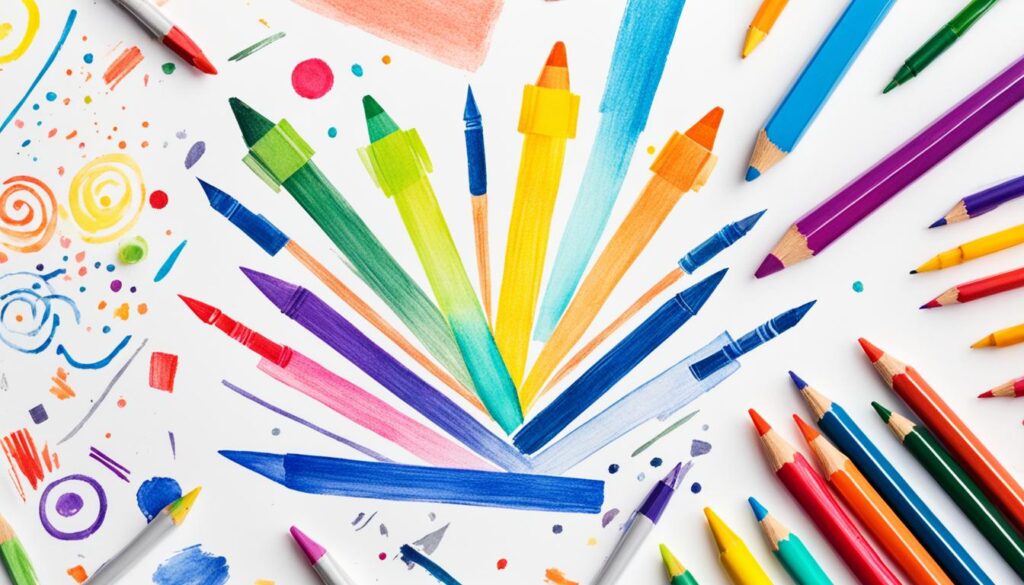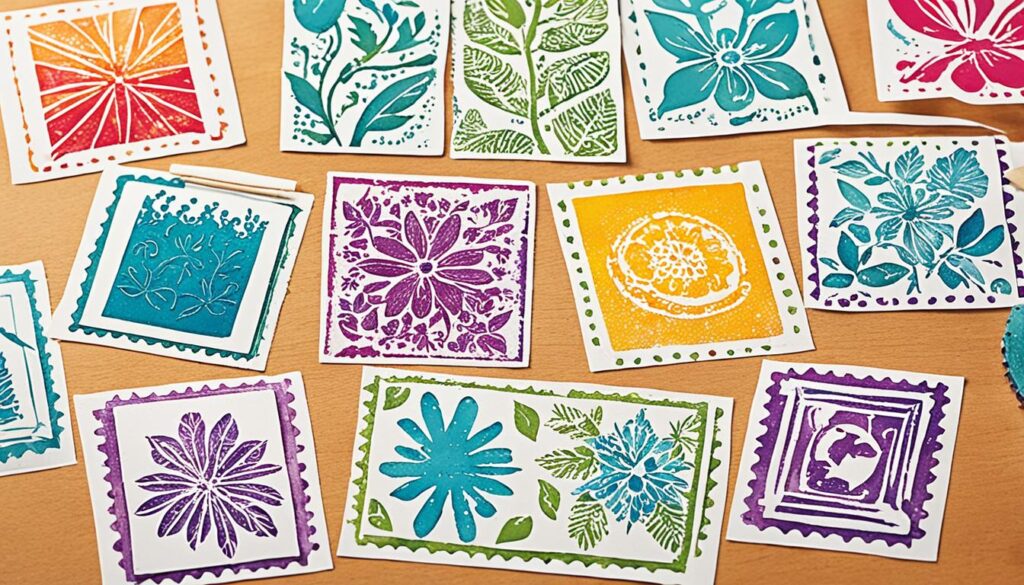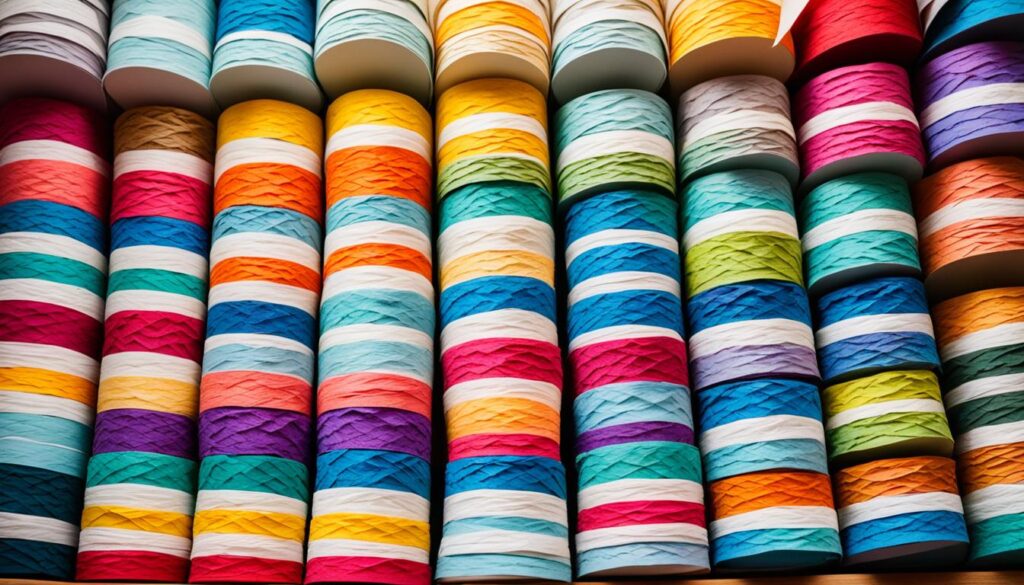Welcome to the world of Montessori art! If you’re looking to create an engaging and stimulating art space for your young learners, you’ve come to the right place. In this article, we will guide you through some exciting Montessori art shelf ideas that will spark creativity and curiosity in your students.
Setting up a Montessori art shelf is a fantastic way to introduce art literacy and nurture basic art skills in children. By providing a carefully curated selection of materials and supplies, you can empower children to explore their imagination, express their emotions, and develop their artistic abilities.
So, let’s dive into the wonderful world of Montessori art activities and discover the essential materials that will make your art shelf a hub of inspiration for your little artists.
Fill the Art Shelf with Baskets of Paper
When setting up your Montessori art shelf, one essential item you should include is a variety of paper options. Providing different types of paper allows children to explore various art mediums and techniques, fostering their creativity and artistic skills.
Baskets of Paper Options:
- Uncoated white drawing paper
- Absorbent watercolor paper
- Colored craft paper
- Large roll of butcher paper
- Canvas fabric for special painting
- Cardboard type papers for crafting and gluing
By offering an assortment of paper, you encourage children to experiment with different textures, colors, and sizes. This not only enhances their artistic abilities but also promotes sensory exploration and fine motor development.
Remember to organize these paper options in baskets on your art shelf, making it easy for children to access and choose the paper they want to use for their art projects.
By filling your art shelf with baskets of paper, you create an inviting space for children to freely express their creativity through drawing, painting, and crafting. This collection of paper supplies encourages them to explore their artistic ideas and develop a love for art.
Include a Variety of Painting Supplies
When setting up your Montessori art shelf, it’s important to include a variety of painting supplies to foster creativity and exploration. By offering different types of paints and paintbrush sizes, you can provide children with a range of options to express themselves artistically.
Start by including classic options such as watercolor and tempera paint. These paints are easily washable and safe for children to use. Additionally, consider introducing student-grade acrylic paints for older students who may be ready for a more advanced painting experience.
Experimenting with different painting tools can also enhance the artistic process. Add sponges to the art shelf to encourage children to explore different texturing techniques and create unique patterns. Paint droppers are another fantastic tool that allows for precision and control, enabling children to experiment with color mixing and create interesting effects.
To further support creativity, include items that can be used for creating textures in paintings. Consider adding everyday objects such as jar lids, combs, or natural materials like leaves or twigs. These items can be dipped in paint and pressed onto paper to create fascinating textures and patterns.
Remember to provide a range of paintbrush sizes to accommodate different projects and preferences. Offer small brushes for detailed work and larger brushes for bolder strokes. This variety will give children the freedom to experiment with different brush techniques and styles.
“The arts are a fantastic way for children to express themselves and develop their creativity. By including a variety of painting supplies on your art shelf, you encourage children to explore different techniques and experiment with colors and textures. This fosters a love for art and allows children to develop their artistic skills.”
Provide Drawing and Doodling Supplies
When it comes to artistic expression, drawing holds a special place. Not only does it allow children to unleash their creativity, but it also helps develop fine motor skills and hand-eye coordination. By including a variety of drawing materials on your Montessori art shelf, you can provide children with endless opportunities to explore and experiment with different techniques. Here are some essential drawing supplies to include:
- Crayons: Crayons are a staple in any art collection. They come in various colors and are easy for young artists to hold and control.
- Colored Pencils: Colored pencils offer a more precise and detailed approach to drawing. They allow children to experiment with shading and blending.
- Oil Pastels: Oil pastels provide vibrant colors and a smooth texture. They are perfect for creating bold and expressive artwork.
- Soft Pastels: Soft pastels are great for blending and creating soft, ethereal effects. They work well on textured paper.
- Tempera Sticks: Tempera sticks are a mess-free alternative to paints. They offer the same vibrant colors and can be easily applied to paper.
- Sketching Pencils: Sketching pencils are essential for more advanced artists. They come in various grades, allowing children to experiment with different shades and textures.

These drawing supplies open up a world of possibilities on the art shelf. Children can create realistic drawings, express their emotions, or simply doodle and have fun. Encourage them to observe the world around them and translate their observations onto paper. The drawing supplies on the art shelf provide endless opportunities for self-expression and artistic growth.
Stock up on Crafting Supplies
When setting up your Montessori art shelf, it’s essential to ensure you have a wide range of crafting supplies to inspire creativity and imagination in your students. Here are some crafting essentials that you should include:
- Glues: Provide non-toxic glue sticks and liquid glue for various craft projects.
- Tape: Include clear tape, colored tape, and washi tape for securing materials and adding decorative touches.
- Scissors: Offer child-sized scissors with blunt tips to promote safe cutting activities.
- Staplers: Include mini staplers or stapler punches to introduce basic office supplies and encourage students to create neat and organized artwork.
- String or yarn: Provide a variety of colors and thicknesses for weaving, wrapping, and threading activities.
- Small embellishments: Add buttons, sequins, beads, googly eyes, and other small decorative items that can be glued onto crafts.
- Wood scraps or popsicle sticks: Include small wooden pieces that can be used for constructing structures, creating collages, or stirrers for mixing paints.
By offering a well-stocked selection of crafting supplies, you invite your students to dive into their imagination and create unique masterpieces. These materials enable them to explore different textures, shapes, and colors while developing their fine motor skills and artistic expression.
Next, let’s explore the fascinating world of modeling clay and how it can engage young minds in creative sculpting:
Section:
Introduce Modeling Clay
Modeling clay is a valuable addition to your Montessori art shelf, offering countless ways for children to engage in hands-on creativity. Not only does it allow for the exploration of artistic expression, but it also plays a crucial role in developing fine-motor movements in young learners.
When stocking your art supplies, include a variety of modeling clay options to cater to different preferences and project needs. Consider offering quick-drying clay for instant gratification, as well as non-hardening clay for long-term creations.
Enhancing the Clay Modeling Experience
To make the most of modeling clay activities, consider including various tools that can enhance the experience. Shape cutters allow children to create precise and intricate designs, while rolling pins help them flatten and shape their clay creations.
Textured plates provide an added element of creativity, allowing children to imprint patterns and designs onto their clay projects. Wooden modeling tools are versatile and can assist in sculpting and detailing clay designs.
“Modeling clay encourages sensory exploration and provides a tactile learning experience for children. It engages their imagination and fine-tunes their motor skills.”
Introducing modeling clay on the art shelf not only cultivates artistic skills but also promotes concentration and problem-solving ability. It allows children to express themselves freely and fosters a sense of pride and accomplishment in their artwork.
Get Creative with Stamps and Stencils
Stamps and stencils are excellent additions to your Montessori art shelf. Not only do they spark creativity, but they also provide opportunities to work on fine motor skills and hand-eye coordination. Stencils allow children to trace intricate designs and build their dexterity, while stamps can be used with clay or ink pads to create unique patterns and images.
When selecting stamps and stencils for your art shelf, aim for a diverse collection that caters to different interests and themes. Include a variety of shapes, letters, animals, and objects to inspire imaginative artwork. Young artists will enjoy exploring with stamps and discovering how they can be combined to create beautiful compositions.
“Stamps and stencils are not only fun, but also educational tools that can enhance a child’s artistic expression. By offering a variety of options, children can unleash their creativity and develop their own unique style.”
Consider surprising your students with new stamp designs every now and then. The element of surprise keeps the art shelf dynamic and encourages exploration. Don’t be afraid to experiment with different ink pad colors or encourage children to create their own patterns by mixing stamps with other tools on the art shelf.
Remember, the art shelf is a space for self-expression and creativity. Stamps and stencils are valuable additions that can help children explore their artistic abilities and develop a love for art.

Add Small Accessories for Extra Oomph
When it comes to creating art, every detail matters. That’s why including small accessories on your Montessori art shelf can add that extra oomph to your students’ projects. Buttons, seeds, beans, and other small embellishments provide the perfect opportunity for students to let their creativity shine.
By offering these small accessories, you give your students the freedom to add unique details and personal touches to their artwork. It’s a chance for them to express their individuality and make their projects truly their own.
Imagine the joy on their faces as they carefully select the perfect button or seed to complement their masterpiece. These little touches can make a big difference and help your students develop an appreciation for the finer details in art.
Not only do small accessories enhance the visual appeal of their creations, but they also provide opportunities for tactile exploration. Children can feel the smoothness of a button, the texture of a seed, or the shape of a bean. It’s a sensory experience that adds another dimension to their artwork.
Incorporating small accessories into your art shelf also encourages resourcefulness and problem-solving. Students can experiment with different materials, explore color combinations, and discover new ways to use these small items in their artwork.
As you guide your students through the art-making process, encourage them to unleash their creativity with the small accessories available on your Montessori art shelf. Watch as their imaginations soar and their projects come to life.
Take a moment to pause and really observe your students as they work with the small accessories. You’ll witness their concentration, their attention to detail, and their excitement as they experiment with different materials. It’s these little moments that make the Montessori art shelf an invaluable tool for fostering creativity and self-expression.
Provide Seasonal Inspiration
One of the best ways to keep the Montessori art shelf interesting and engaging throughout the year is by providing seasonal inspiration. By rotating out stencils or offering still life props that reflect the changing seasons, you can give your students new tools and ideas to spark their creativity.
Consider incorporating items like leaves, flowers, or shells during the fall and spring months. These natural elements can serve as both inspiration and art materials. For example, students can use leaves as stamps or create collages with pressed flowers.
During the winter season, you can introduce winter-themed stencils and props like snowflakes or snowmen. This allows children to explore seasonal themes and create artwork that reflects their experiences and observations.
And don’t forget about the summer months! Include seashells, sunglasses, or other beach-related objects to evoke a sunny, playful atmosphere. Encourage students to express their memories or aspirations related to summer through their art.
By incorporating seasonal inspiration into the Montessori art shelf, you provide your students with a rich and varied creative experience. They will not only enjoy the novelty of new materials, but they will also develop an appreciation for the beauty of nature and the ever-changing world around them.
Conclusion
Setting up a Montessori art shelf in your classroom provides an excellent opportunity for children to explore their creativity and enhance their artistic skills. By offering a diverse range of art supplies and materials, you can foster self-expression and encourage independent art making among your students. From paper and paints to drawing supplies, crafting materials, and clay tools, a well-stocked art shelf is a catalyst for inspiration, enabling children to develop a love for art.
Engaging in Montessori art activities not only allows children to express themselves but also nurtures important cognitive and motor skills. Through hands-on exploration with various art supplies, they can learn about colors, textures, shapes, and patterns while improving their fine motor dexterity. The art shelf becomes a place where young artists can experiment, make choices, and bring their imaginations to life.
The Montessori classroom art is a space where children can freely explore different mediums and techniques, building their artistic confidence. By providing a rich assortment of art supplies like brushes, paints, clay, and collage materials, you create an inviting environment that encourages curiosity and creative problem-solving. The art shelf becomes a canvas for imagination and self-discovery, fostering a lifelong appreciation for the arts in young minds.
FAQ
What are some ideas for setting up a creative Montessori art shelf for kids?
Setting up a Montessori art shelf can provide children with a space to explore their creativity and develop their artistic skills. Here are some ideas to consider when setting up an art shelf:
What should I include in the art shelf?
When setting up an art shelf, it’s important to provide a variety of materials for different art activities. Some essential items to include are:
What kind of paper should I include in the art shelf?
Fill the art shelf with a variety of paper options such as uncoated white drawing paper, absorbent watercolor paper, colored craft paper, large rolls of butcher paper, canvas fabric for special painting, and cardboard type papers for crafting and gluing.
What painting supplies should I include in the art shelf?
It’s important to include different types of paints, such as watercolor, tempera paint, or student-grade acrylic, and provide a variety of paintbrush sizes. You can also experiment with painting tools like sponges, paint droppers, and items for creating textures.
What drawing supplies should I provide?
It’s beneficial to include a variety of drawing materials such as crayons, colored pencils, oil pastels, soft pastels, tempera sticks, and sketching pencils. These materials can be alternatives to painting when messiness is a concern.
What crafting supplies should I include?
Include a variety of glues, tape, scissors, staplers, string or yarn, small embellishments like buttons and googly eyes, and small wood scraps or popsicle sticks for crafting projects.
Why is modeling clay important for the art shelf?
Modeling clay is important for teaching fine-motor movements. Include different types of clay such as quick-drying or non-hardening. Clay tools like shape cutters, rolling pins, textured plates, and wooden modeling tools can enhance the clay modeling experience.
How can I incorporate stamps and stencils into the art shelf?
Stencils are fun for tracing and building hand dexterity, and stamps can be used in clay or with ink pads. Include a variety of stencils and surprise students by adding stamps to the art shelf.
What small accessories should I provide?
Buttons, seeds, beans, and other small accessories can give students the freedom to add details and embellishments to their projects. These items allow for creative expression and individuality in art.
Should I provide seasonal inspiration in the art shelf?
Yes, rotating out stencils or offering still life props to reflect the changing seasons provides students with new tools and inspiration. This keeps the art shelf interesting and engaging throughout the year.
How can setting up a Montessori art shelf benefit students?
Setting up a Montessori art shelf creates a space for children to explore their creativity and develop their artistic skills. By including a variety of art supplies and materials, students can engage in self-expression and independent art making.



